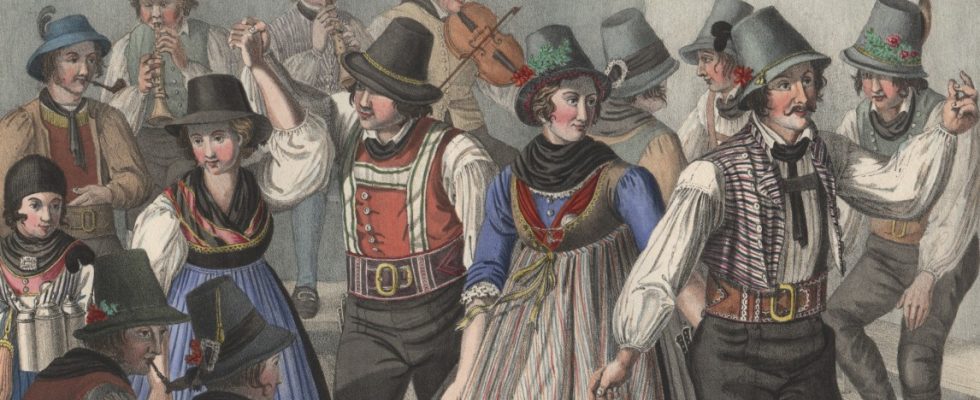Laptop and lederhosen, that sounds good in Bavaria. But long hair on a Schuhplattler? Because their sons’ hairstyles were repeatedly criticized in the local traditional costume club in Trostberg, Evi and Markus Heigermoser left with the entire family. There were insinuations that the boys appeared “sloppy,” says Evi Heigermoser. At the general meeting in January, the family was addressed again in front of everyone: the hair should go. “That was the end point” – and the trigger for the decision to leave the family of six, including both sons and two daughters. Several media outlets reported about it.
The step is not directed against tradition and customs, emphasizes Evi Heigermoser, who was the club’s secretary for a long time. But there should be no exclusion. “We want to educate and awaken people,” she says. “We want them to wake up. I want them to become more open.” The hair is just the tip of the iceberg here.
What is custom – what can be discussed and what can be changed? Opinions differ. The hairstyle is part of the costume; The women have to put their hair up, says Michael Hauser, board member of Gauverband I, the largest association of traditional costume clubs in Bavaria. After all, there are also requirements for hairstyles elsewhere; in Oberammergau, men have to let their hair grow for Passion.
“The problem is not that you set up rules, but that you evaluate them. That has little to do with tolerance,” says Alexander Karl Wandinger, traditional costume advisor for the Upper Bavaria district. “Traditional costume clubs need rules, that’s completely clear. But we have to renegotiate: Does that still fit into our times?” says the traditional costume expert. “We will always have changes, and that’s a good thing. That shows that something is alive. Cultural forms that don’t change from time to time die.” Schuhplatteln has also changed. For example, there used to be more individual figures.
For Hauser, on the other hand, a “consensus has developed” on how traditional costumes should be worn in public. “The traditional costume has developed this way, this is how we know it, this is how we are known at home and abroad. The more stylish and dashing it looks, the more popular it is.” Long hair is not a problem as long as it doesn’t involve public appearances in traditional costume. In the Trostberg case, with good will, “a consensus could certainly have been found,” says the Gauverband board.
But that just didn’t work. The family of six – two daughters in addition to the five and 15 year old boys – were intensively involved and rooted in the traditional costume club. Like their own parents, the parents had been members since childhood; the father looked after the website, was at times a board member and most recently a youth leader. “Nobody came forward after leaving,” says Evi Heigermoser. “Silence.”
The board of the local traditional costume association is no longer able to comment on this, nor is a deputy. The club’s second Vorplattler, Andreas Zenz, takes a relaxed view of things. “I used to have longer hair and was allowed to take part,” he says. “I don’t believe in not letting children take part just because they have longer hair.” But he only speaks for himself, he emphasizes. There are different opinions in the club.
At the Kirchweihfest in Trostberg, two boys in traditional costume with long hair hammer nails into a tree stump. You can also see a son of the Heigermoser family (left).
(Photo: Tine Limmer/dpa)
Long hair also brings real disadvantages to ambitious platers. “When it comes to Preisplatteln, points are deducted if you have long hair; the best top platter can never come first,” says Evi Heigermoser. The 15-year-old son Done also left “because the comments were too much for him”. His main sport is ice hockey anyway. He also let his hair grow because his Canadian idols wear long hair. “Ice hockey looks cool,” says the mother. Five-year-old Simmerl, on the other hand, no longer understands the world since he stopped going to the club to play records. “The little one played passionately. He had so much fun.” Nevertheless, it is clear to the boy: “He doesn’t cut his hair.”
Long hair on men – that has had different meanings over time. In the 1960s it was seen as a protest against bourgeois society – which in turn classified long-haired people as bums. In earlier centuries things were seen differently. “For centuries, men were proud of their long hair,” explains traditional costume expert Wandinger.
Karl-Heinz Knoll, President of the Munich Festring, who, among other things, organizes the large traditional costume and rifle parade for the Oktoberfest with around 9,000 traditional costumers from many countries, shakes his head. “I certainly don’t interfere in the affairs of the traditional costume association,” he emphasizes right from the start. But: “As far as I know, all traditional groups have great difficulty finding young people. I wouldn’t frustrate any young people by using their hairstyle to minimize their dancing and platemaking skills.”
Before the traditional costume clubs came into being around 1880, “long hair was common practice among men,” explains Knoll. “There is personal freedom. What else do we want to regulate?” He saw a photo of one of the boys with long hair. “That actually looked nice.” Incidentally, the hair thing is “not so tragic”: “Most traditional costumes include a hat.” This means that the hair disappears under the headgear anyway.

